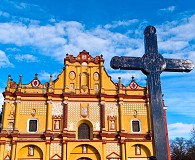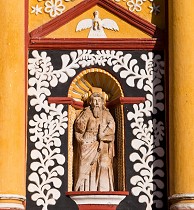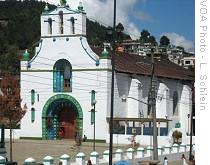Chiapas, Mexico
03 August 2009
Chiapas, Mexico has a vibrant religious scene. The country is predominantly Catholic. However, other faiths abound, ranging from ancient Mayan rituals to modern-day Evangelicals. Many indigenous people mix Christianity with Indian beliefs. A hybrid form of religious practice is dramatically observed among indigenous people in San Juan Chamula, an isolated settlement in the highlands of Chiapas.
 |
| Templo de Santo Domingo, San Cristobal de las Casas in Chiapas, Mexico |
"The Catholic Church always prayed in the dark, inside the church and silently. You know, it is a conversation between you and your God," journalist Kyra Nunez said.
She explains that the Catholic Church increasingly has to compete with new forms of worship springing up to attract members to the faith.
"And, one of the forms of attracting people is music," she explained. "So, the prayer, the normal prayer - Hail Mary or whatever - they do it singing, and dancing and expressing themselves and...apparently getting into the mood of the people."
Religious tensions can be intense
 |
| Religious statue at the Templo de Santo Domingo in Chiapas, Mexico |
Social and religious warfare between Indian converts to Evangelical Protestant religions and adherents of a traditional Indian form of Roman Catholicism hit a high point in the 1990's. Scores of people were injured during open clashes between the groups.
The municipal president of San Juan Chamula, Domingo Lopez Gonzalez, oversees 148 communities within the area. He tells VOA religious problems between Evangelicals and Catholics persist in a number of the small communities. But, he says San Juan Chamula, itself, has no problems because people are allowed to worship as they wish.
Gonzalez and two other political leaders enter the Church of Saint John the Baptist, which dominates the Central Plaza.
The men, who are wearing heavy white sheepskin ponchos, stand at the back of the church and chant a prayer in Tzotzil, one of seven Mayan languages spoken in Chiapas. The chant is hypnotic in its repetitive insistence. The dimly lit church is illuminated by hundreds of candles. The thick, sweet smell of incense wafts upwards from burning cups.
Groups of people form small circles. Some kneel before floral offerings. Some pray and sing in a strange fusion of ancient Mayan tradition and Catholic practice. Some swig moonshine. Others imbibe from large bottles of Coca Cola because belching is believed to expel evil spirits.
Many people hold small animals. The disquieting sound of periodic screeches from chickens, ready for slaughter, punctuates the air.
Catholicism mixes with ancient Mayan religion
 |
| Church of Saint John the Baptist in San Juan Chamula |
"They believe that if they kill the animal, they can be helped," Castilla explained.
| REPORTER: "Do they kill the animal here?" |
| CASTILLA: "Sure, sure. They kill it here." |
| REPORTER: What sort of animals are sacrificed?" |
| CASTILLA: Normally, the dog, chicken, dogs and cats. The white chicken or black chicken. It depends on the problem." |
The Spanish conquered the region in the 16th Century. The invaders brought their Catholic religion to the native people. Although the Mayans accepted the new European faith, they infused it with symbols of their own ancient beliefs.
The Mayans found it easy to adopt the cross. They note that, before the conquest and before Christ, the cross was symbolic of the ceiba tree, which the ancient Maya believed stood at the center of the universe.